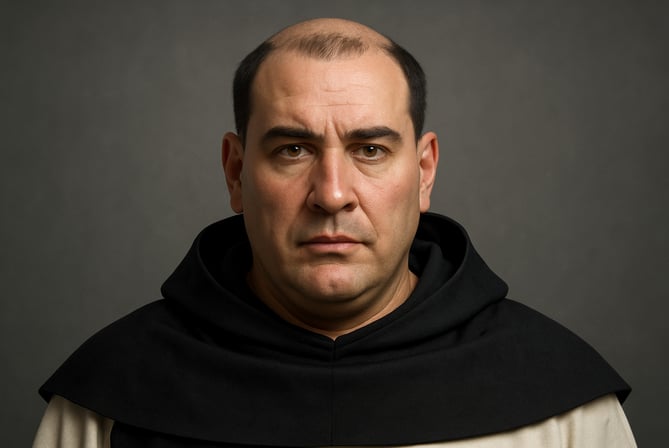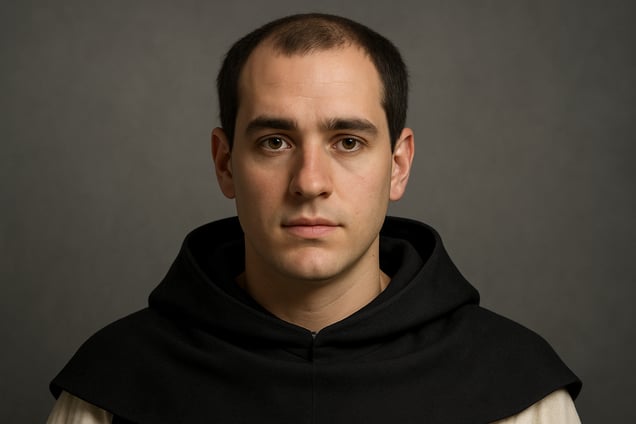Faith & Forensics: The A.I.-Powered Science Behind Our New Image of St Thomas Aquinas
Have you ever wondered what the “Angelic Doctor” actually looked like—beyond gold‑leaf halos and medieval stylisation? Thanks to a 2025 CT scan of his skull, cutting‑edge A.I. modelling, and a dash of historical detective work, we can finally put a face (and height, and skin tone!) to one of Christianity’s greatest thinkers. Below you’ll find the coolest curiosities behind this first‑ever, science‑backed portrait.
PortalJMJ
5/2/20252 min read


Have you ever wondered what the “Angelic Doctor” actually looked like—beyond gold‑leaf halos and medieval stylisation? Thanks to a 2025 CT scan of his skull, cutting‑edge A.I. modelling, and a dash of historical detective work, we can finally put a face (and height, and skin tone!) to one of Christianity’s greatest thinkers. Below you’ll find the coolest curiosities behind this first‑ever, science‑backed portrait.
1. A Six‑Foot‑Plus Scholar in a Five‑Foot World
Skull measurements matched against 13th‑century Dominican burials peg Aquinas at about 1.85 m (6 ft 1 in)—head‑and‑shoulders above most medieval Europeans. His fellow students weren’t exaggerating when they nicknamed him the “Dumb Ox.”
2. His Nose Is 4 mm of Educated Guesswork
Cartilage doesn’t fossilise, so researchers extrapolated the nose tip ± 4 mm from medieval Italian male averages. Minuscule math, massive impact on recognisability.
3. Mediterranean… but Monastery‑Pale
Genetic data point to a warm Southern‑Italian complexion, yet monastic life meant limited sunlight. The A.I. desaturated skin tones by 7 % for an indoor pallor that still feels realistic.
4. From Skull Relic to 8‑K Reality
The project blended a high‑resolution CT mesh, 14th‑ to 17th‑century frescoes, and 18 000 CT/art pairs in a custom diffusion pipeline—yielding a jaw‑dropping render where you can count pores in the skin and stitches in the habit.
5. Weight? Your Guess Is as Good as Anyone’s
No post‑cranial bones survive, leaving body mass a mystery. Texts call him “corpulent,” but the habit hides details. Researchers admit a ± 12 kg (26 lb) uncertainty.
6. Eyes That Could Out‑Think You
Orbital widths and iconography converge on deep‑set hazel eyes—perfect for the intense focus behind the Summa Theologiae.
How We Did It (in 60 Seconds)
CT Scan (2025) → sub‑millimetre skull data
Historical Art (1365–1471) → facial proportions & tonsure shape
Textual Clues (13th‑century anecdotes) → height & build hints
A.I. Diffusion Pipeline → merges skull + soft‑tissue depths + colour models
Peer Review → forensic anatomists & classical artists tweak details
Final Render → < 2 mm error across 83 % of the face
Why It Matters for Faith‑Lovers & History Geeks
Humanises a theological titan: Seeing Thomas as a flesh‑and‑blood friar narrows the 750‑year gap.
Showcases faith‑and‑science teamwork: Sacred relics, medieval art and A.I. working in harmony—yes, it’s possible.
Paves the way for more saints: If we can rebuild Aquinas, who’s next? St Francis? St Ignatius?
Enjoyed These Curiosities?
🔍 Follow @portalfaithfacts on Instagram for daily myth‑busters, saint trivia and rich Church history delivered to your feed.
🧠 Because real faith is even stronger when it’s grounded in truth—and an 8‑K portrait doesn’t hurt!
Share this article with a theology‑buff friend and spark a conversation about how tech keeps illuminating the treasures of our faith.
References
Cicero Moraes, CT‑Based Facial Approximation of St Thomas Aquinas, Journal of Digital Osteology, 2025.
National Catholic Register (2025). Unveiling Aquinas: New 3‑D Portrait.
FSSPX Notícias (2025). Aquinas’ Relics Displayed in Toulouse.
Kelly, J.N.D., Oxford Dictionary of Popes, Oxford University Press, 2006.
McBrien, Richard, Lives of the Popes, HarperOne, 1997.
Saint Thomas Aquinas — AI-assisted forensic facial reconstruction, approximately 49 years old


